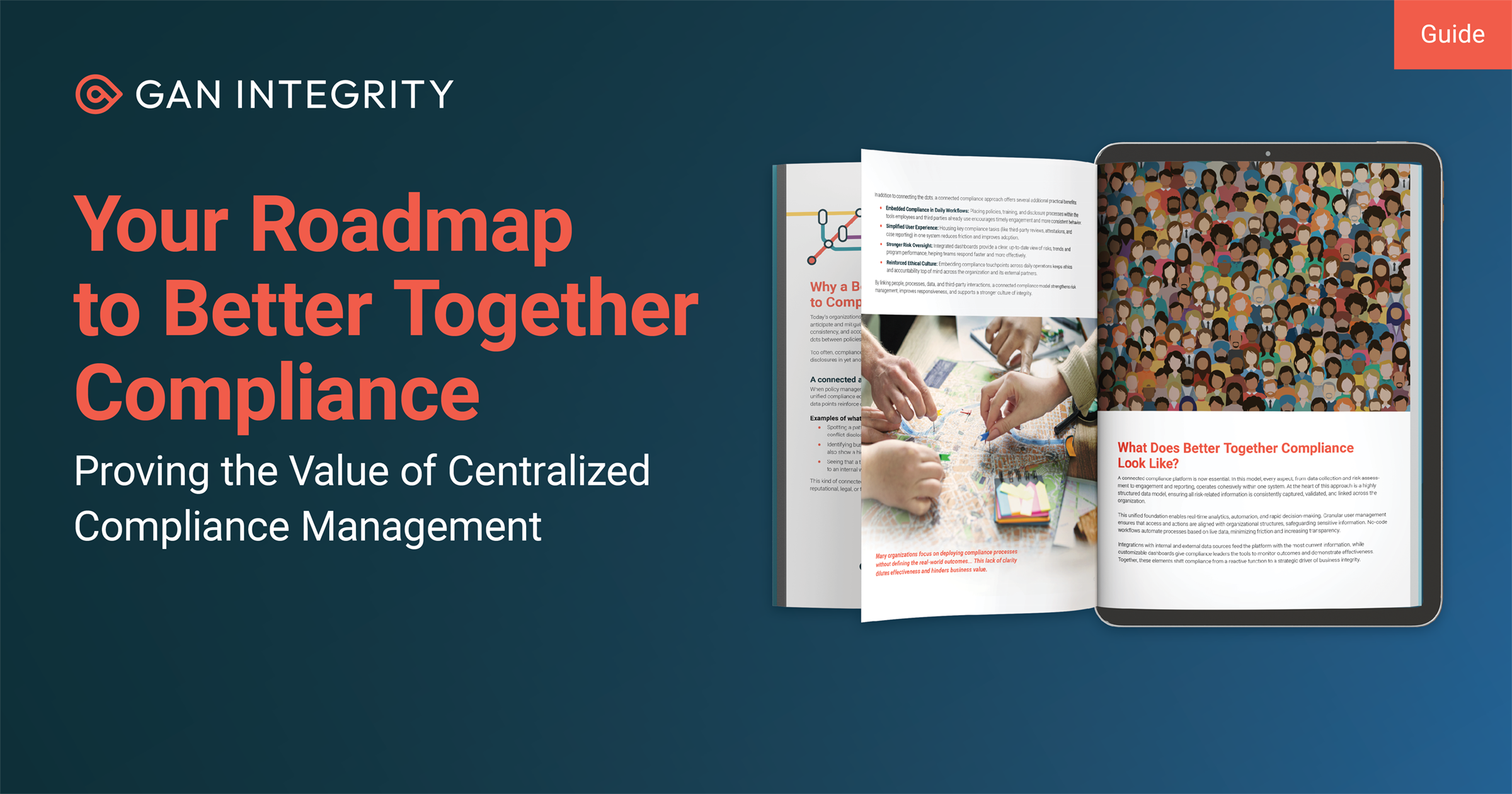In the interconnected digital economy, third-party relationships underpin not just business operations but also a vast landscape of potential risks. Supply chain disruptions, data breaches, regulatory failures, and reputational threats all frequently tie back to external vendors, partners, and suppliers. This is the world of Third-Party Risk Management (TPRM), and it's evolving rapidly, thanks in large part to advances in technology and a sharper focus on actionable decision-making.
This blog explores key insights from the recent “TPRM Technologies and the Art of Decision Making” webinar, featuring Willem Punt (General Manager TPRM at Rio Tinto) and Matt Kelly (Editor and CEO of Radical Compliance). While these experts, and host Colin Campbell, bring their own angles, the broader discussion revolves around why TPRM matters now more than ever, how technology is changing the game, and how organizations can leverage both to make smarter, faster, and defensible risk decisions.
Why Modern TPRM Matters
The risks posed by third parties, be they suppliers, service providers, distributors, or even customers, have moved front and center for business leaders. Several trends are driving this focus:
Regulatory and Stakeholder Pressure
Legislative requirements around data privacy, anti-bribery, supply chain transparency, and cybersecurity are more demanding. Global enterprises are expected to know not just what their third parties do, but how they operate, manage risk, and maintain compliance. Stakeholders and customers similarly want assurance that businesses can trust their partners, and that failures won’t cascade upward.
Escalating Real-World Fallout
Famous data breaches, fraud scandals, and operational breakdowns often trace to third parties, not organizational employees. These incidents lead to financial losses, regulatory penalties, and enduring damage to brand reputation.
Efficiency and Strategic Agility
Third-party ecosystems aren’t just risk vectors; they’re also drivers of innovation and competitive value. Firms must balance robust risk mitigation with operational efficiency, enabling the business to move quickly when onboarding new partners or responding to fast-moving threats.
Pillars of Effective TPRM
To manage and mitigate these risks, mature TPRM programs rest on several interlocking pillars:
High-Quality, Current Risk Information
At the core of every decision is the data behind it. For TPRM, that means organizations need reliable, up-to-date information on their third parties covering:
- Ownership structures and beneficial owners
- Regulatory compliance records
- Cybersecurity maturity
- Financial stability and creditworthiness
- ESG (environment, social, governance) factors
Collecting data is just the start. The processes used to validate, update, and analyze this information (ideally in near real-time) are what allow risk teams to stay ahead of problems before they become crises. Outdated or incomplete profiles lead to false confidence or missed threats.
Rigorous Scoping and Prioritization
TPRM programs must begin by mapping out the entire third-party universe. That means not just primary vendors, but also subcontractors, consultants, affiliates, and any other party with access to your data, systems, or intellectual property.
Once mapped, third parties must be segmented and prioritized:
- Who touches the most sensitive data?
- Which relationships are mission-critical for business continuity?
- Where does geographic, legal, or regulatory complexity introduce more risk?
Segmentation isn’t just about compliance, it’s about making sure finite resources are applied where the risks (and impacts) are greatest.
How Technology is Transforming TPRM
Technology has shifted TPRM from a laborious, paper-driven function into a strategic, data-rich discipline. The most impactful advances include:
Centralized Risk Management Platforms
Modern TPRM platforms create a single source of truth for third-party relationships. This centralization streamlines onboarding, due diligence, and ongoing risk reviews. Instead of siloed spreadsheets and endless email chains, risk data lives in one accessible, secure environment.
Automated Risk Assessments and Monitoring
Automation enables organizations to conduct standardized risk assessments across thousands of vendors, surfacing issues much faster. These tools go beyond spreadsheets, using dynamic questionnaires, linkage to external data sources, and adaptive workflows that flag high-risk responses in real time.
Importantly, technology also enables continuous monitoring: scanning for financial, regulatory, cybersecurity, and reputational changes as they happen rather than just at onboarding or contract renewal.
Advanced Analytics and Artificial Intelligence
AI is increasingly woven into TPRM platforms, helping organizations detect patterns, anomalies, and signs of emerging risk. Due diligence solutions incorporating AI can anticipate which third parties might present the greatest risk based on red flags, automating “early warning” for risk and compliance teams.
This accelerates the move from reactive to proactive risk management, supporting faster, better-informed decisions.
Integrated Incident Response and Audit Trails
Sophisticated tools don’t just flag problems; they help teams take action. Integrated workflows enable IT, legal, procurement, and risk to collaborate on investigations, document decisions, ensure timely remediation, and maintain clear audit trails for regulators or internal auditors.
Moving Beyond Compliance: Strategic Value from TPRM
Traditionally, TPRM’s main function was defensive: avoid noncompliance, prevent vendor failures, pass audits. Today, organizations are reaping additional value:
Operational Efficiency: Automation and standardized workflows reduce the resource burden on risk, procurement, and compliance teams. Faster onboarding and proactive alerts mean less firefighting and fewer business disruptions.
Stronger Decision Support: Dynamic dashboards translate raw assessment data into clear, actionable insights: which vendors need more scrutiny, where controls are effective, and when leadership intervention is needed. This clarity is crucial as the volume and velocity of third-party relationships grow.
Resilience and Brand Protection: Proactive TPRM helps organizations spot brewing issues early (such as financial distress, regulatory violations, security red flags, etc.) before they escalate into full-blown crises. This resilience not only protects financial results, but also reinforces brand trust with customers, investors, and regulators.
Competitive Differentiation: A mature, transparent TPRM program can be a selling point in its own right. Savvy companies use it to demonstrate reliability and commitment to high standards when competing for major deals or regulatory approvals.
Best Practices for High-Impact TPRM Programs
Deliver Actionable Intelligence, Not Just Data
It’s easy to get swamped by details. The goal is to provide decision-makers with concise, relevant summaries: what’s the risk, what’s the recommended response, and how urgent is it? Great programs surface what matters most, empowering quick, defensible action.
Make Monitoring Continuous
Point-in-time vendor reviews are quickly outdated by today’s standards. Effective TPRM programs employ automated systems to watch for changes in vendor health, regulatory standing, or cyber posture, maintaining a living picture of risk.
Tailor Your Approach: Segmentation and Focus
Not all vendors or third parties represent equal risk. Segmentation by criticality, function, regulatory exposure, or geography ensures that intense scrutiny is applied where it’s needed most, maximizing return on risk management investment.
Integrate Cross-Functional Collaboration
TPRM isn’t siloed; it brings together input from IT, legal, finance, operations, and the C-suite. Integrated workflows, shared dashboards, and collaborative incident response ensure that no signals are missed and remediation is swift and effective.
Institutionalize Learning and Adaptation
Build in reviews of real incidents and simulated scenarios. Learning from past vendor failures (yours and others’) ensures the program evolves with the threat landscape and regulatory expectations.
Emerging Trends and the Future of TPRM
Looking to the future, several developments stand to further revolutionize the world of TPRM:
Widespread use of AI and Automation: Predictive analytics, anomaly detection, and even automated remediation workflows are scaling up.
Tougher Regulations and Scrutiny: Legislation around supply chain transparency, data privacy, and ESG will deepen, particularly in global contexts.
Integration of ESG Risk: Environmental, social, and governance factors are being built into risk assessments, reflecting both regulatory and reputational sensitivities.
Board-Level Visibility: TPRM is evolving into a regular topic for boards and the C-suite, signaling its critical role in both risk oversight and strategic planning.
Increased Third-Party Diversity and Complexity: The boundaries of what counts as a third party, including cloud service providers, gig economy vendors, and deep supply chain nodes, are expanding, making robust, scalable technology and intelligence more essential.
Conclusion: From Risk Avoidance to Strategic Advantage
Third-party relationships are essential to business success, but their risks can’t be managed with outdated tools or a compliance-only mindset. At its best, a modern TPRM program enables not just the avoidance of negative outcomes, but the confident pursuit of opportunity, driven by timely intelligence, sensible prioritization, and smart decision-making.
TPRM now sits at the crossroads of operational excellence, digital transformation, and brand protection. By leveraging the right technology, establishing a culture of continuous improvement, and focusing on actionable decisions, organizations can transform third-party risk management from a defensive obligation into a foundational source of value and resilience.
Interested in learning more about TPRM strategies from the experts themselves? Listen to the webinar on-demand at any time!
Blog based on highlights and consolidated discussion from the “TPRM Technologies and the Art of Decision Making” webinar, reflecting industry trends and actionable best practices for organizations navigating third-party risk in 2025 and beyond.

Colin Campbell is Gan Integrity's Strategic Product Marketing and Analyst Relations leader with over 15 years of experience in the SaaS software and tech industry. Colin has led analyst relations and product marketing growth strategies in North America, EMEA, UK and APAC, growing revenues in multiple industries. At GAN Integrity, Colin drives market expansion, demand generation and significantly enhancing customer retention, with a talent for aligning marketing strategies with business goals to deliver results.
